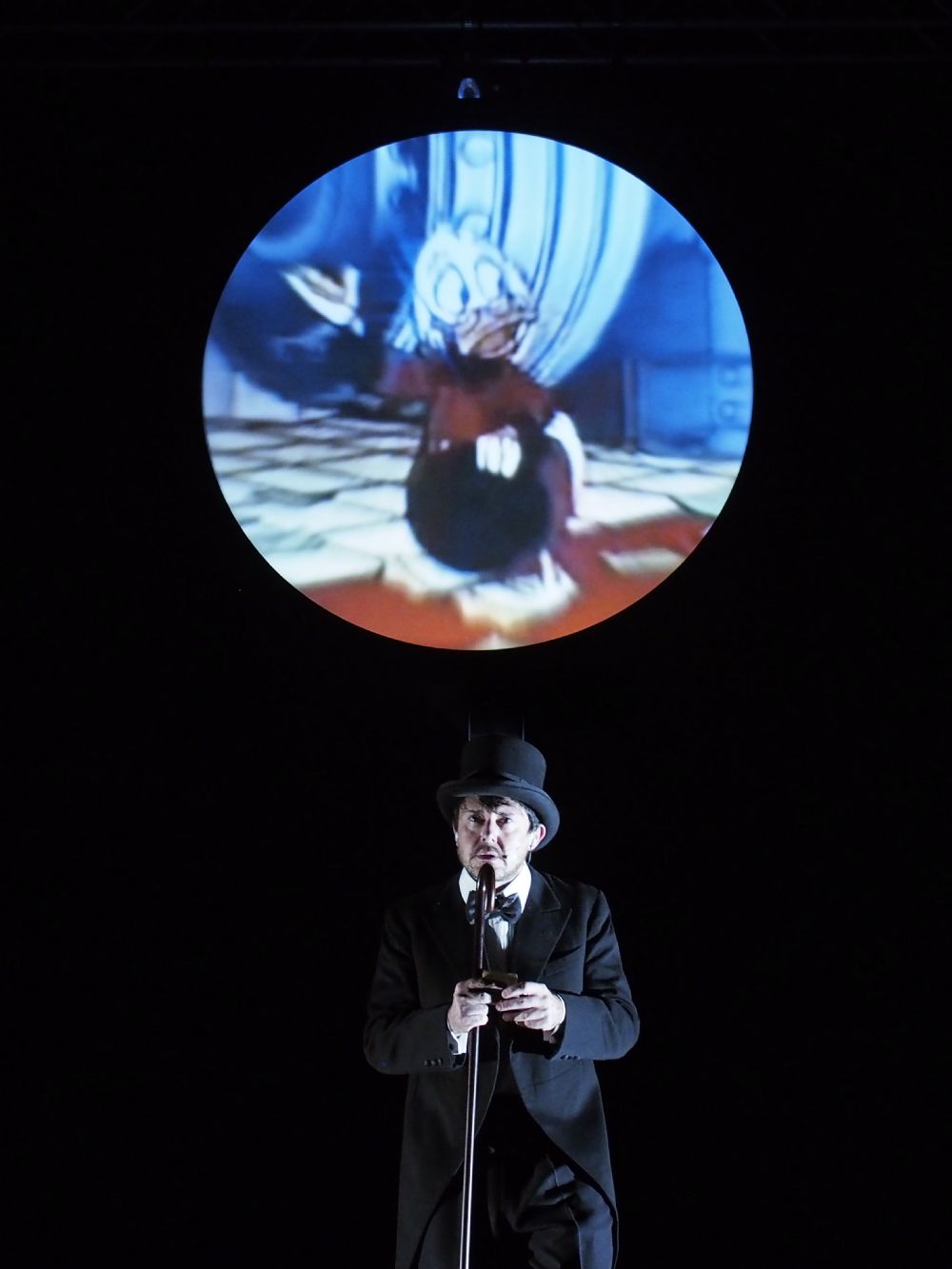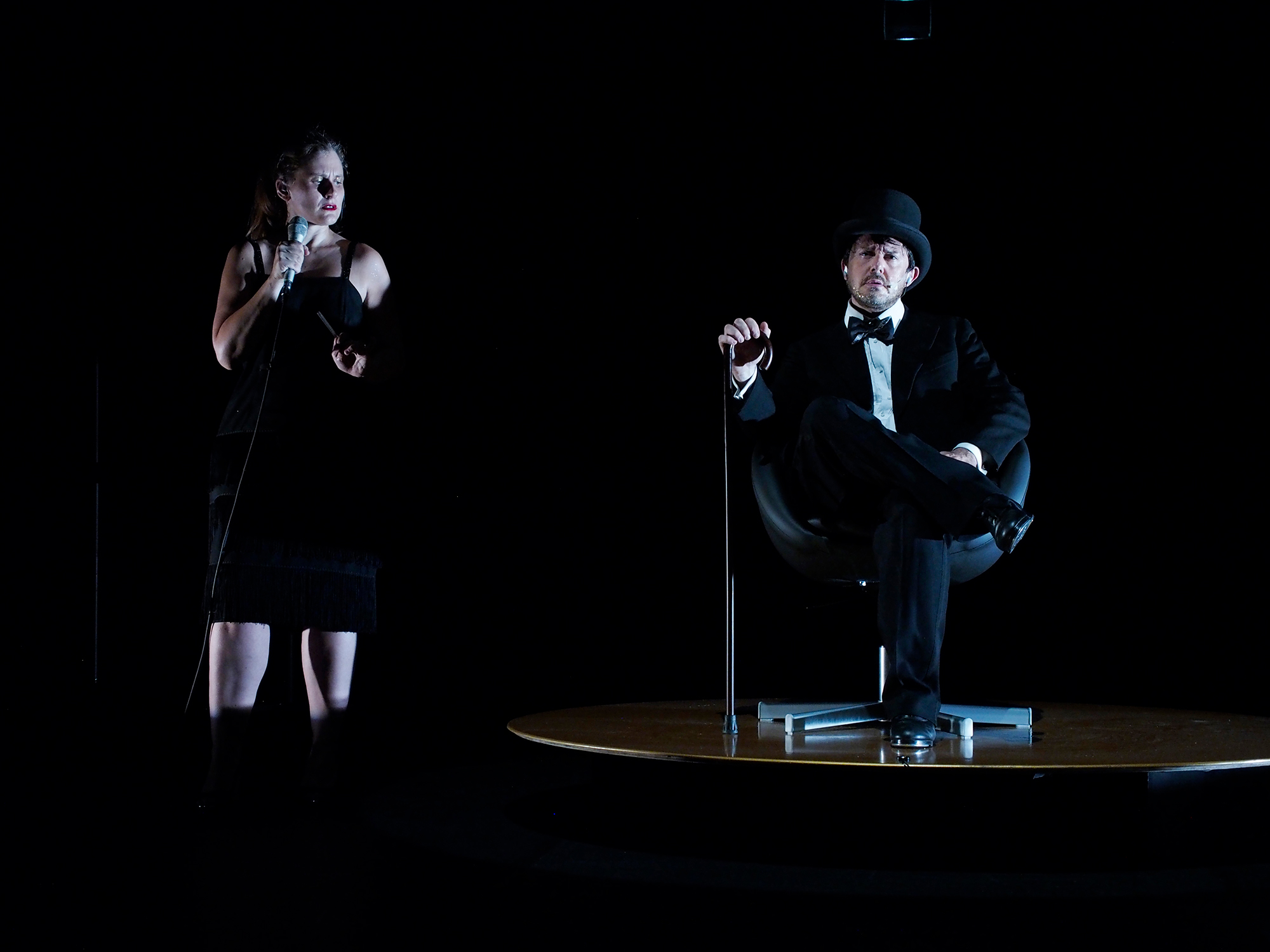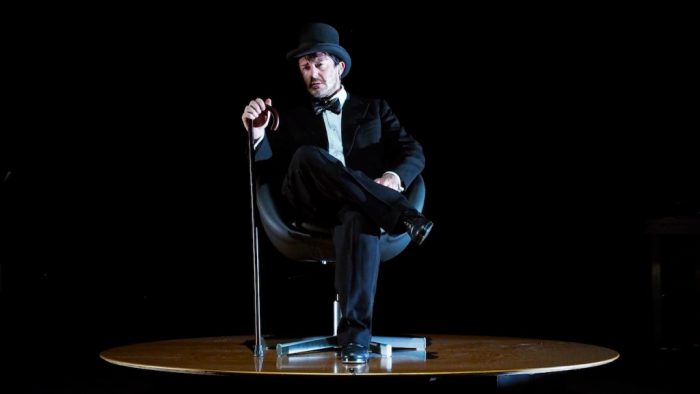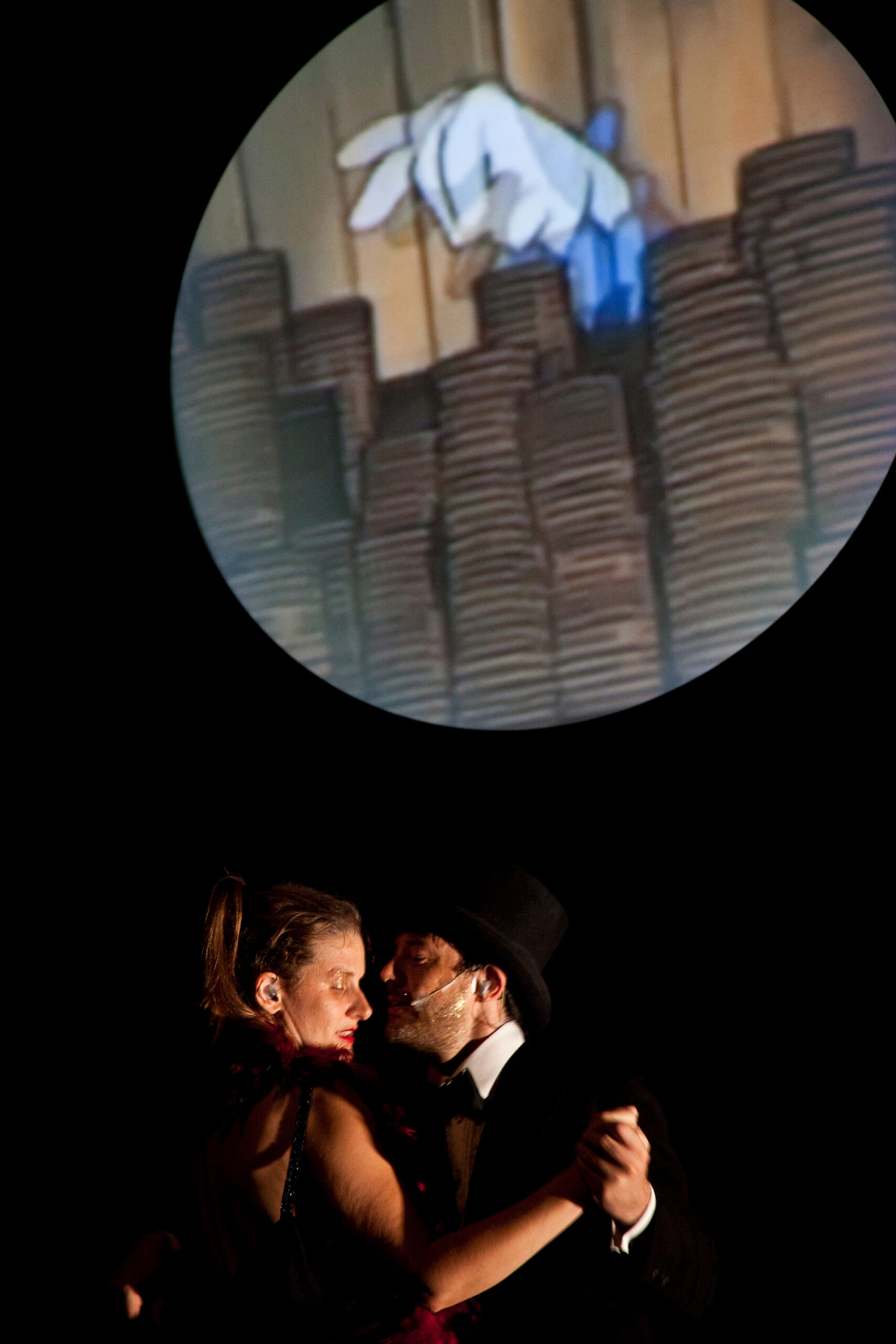Scrooge
PAST DATES
31 July 2015 | Dro (TN), Turbina 2 Centrale Fies, Drodesera
3 November 2015 | Rome, Teatro Vascello, Teatri di Vetro
27 November 2015 | Longiano (FC), Teatro Petrella
4 December 2015 | Ravenna, Artificerie Almagià, Fèsta
23 March 2016 | Florence, Teatro Cantiere Florida
Year : 2015
Ph. Gianluca Panareo
PRESS REVIEWS
- Alessandro Morino, Scrooge or the Banality of Money
- Sarah Curati, “Scrooge” or the Broken American Dream/Fanny & Alexander
- Redazione Nucleo Artzine, Fanny & Alexander, Scrooge
- Laura Gemini, Toxic Myths. Money and Its Imagery in Scrooge, Study for Green Discourse by Fanny&Alexander
- Iacopo Gardelli, “Scrooge” by Fanny & Alexander. The Economics of Illusion
Scrooge or the Banality of Money, by Alessandro Morino, romadaleggere.it, November 4, 2015
From dubbing a Disney animated cartoon to a fresh analysis of the contemporary capitalist world: on stage at the Teatro Vascello – Scrooge – by Fanny & Alexander.
Can society be mocked in a funny and fresh way?
Can we play with the real by turning its ridiculousness into spectacle?
This seems to be exactly what the Fanny & Alexander theater company staged at the Teatro Vascello in Rome on November 3, 2015, with Scrooge. Study for Green Discourse.
The variety of irony in the game of vision, the animation of a Disney classic that is more relevant than ever, still a story that belongs to the present. The mirror is just an eye on the fantasy of a fun story, so witty that it leaves a trace of reality.
The story is based on A Christmas Carol by Charles Dickens, adapted into a Disney cartoon where Uncle Scrooge is, of course, the old and rich miser, concerned only with accumulating, possessing, and counting his wealth.
The protagonist of this story/performance tests his speech starting from the dubbing of this cartoon, offering a very modern lesson on money and its circulation. As an archetype of the savage mode of today’s capitalism, Scrooge seems to metaphorically represent the essential spirit of modern times, all focused on accumulation, power, and the very banality of owning money as absolute control over life and reality.
Thus, he almost becomes a parodic figure of himself. A jester capable of reflecting figures from both the past and present, of being both a comic strip and a parody, ethical and excessive, in a whirlwind as if it were a leap in time from Italy’s economic miracle to the crisis of the global market.
Therefore, the acrobat of money, with a miserly soul and an artist’s heart, able to dance, sing, count, and advise the right way to “do,” finds himself incredulously facing the ghosts of his own life, asking the usual questions, probably without answers, making the audience reflect on the relationship between money and art: Is the economy creative? Is it ethical? Can we talk about ethical economy today? Or is it a paradox at the root of every discourse on the economy itself?
“Scrooge,” or the Broken American Dream – Fanny & Alexander, by Sarah Curati, paperstreet, November 5, 2015
Green is an ambivalent color: on one hand, it represents hope and tranquility, on the other, it symbolizes envy and anger, the snake and its poison. Green is also the color of everything that governs our existence: the dollar. In other words, Capitalism. Scrooge, Study for Green Discourse by Fanny & Alexander, triggers a reflection on the relationship between Man and Money, using the famous character from Walt Disney. So, what better example of love for money than Uncle Scrooge?
Known to us as Uncle Scrooge, he is the richest duck in the world, the embodiment of the self-made man and a projection of the American dream: the one who, starting from poverty, became a billionaire through hard work and personal effort. On stage, Scrooge is played by Marco Cavalcoli in a black tailcoat and top hat, giving a lesson on the history of Money to his three nephews, Huey, Dewey, and Louie (Chiara Lagani, at the side of the stage). But what is the price of being Uncle Scrooge? Money makes people greedy and miserly, it dries up the soul, distances one from themselves and from loved ones; hence, another Scrooge emerges, Ebenezer, the old selfish and miserly man from A Christmas Carol by Dickens. The two stories overlap, contaminate each other, referencing one another with words, dance, and rhyme, while the continuous electronic music (live electronics by Emanuele Wiltsch Barberio) amplifies the echoes and distorts the sounds, multiplying the game of correspondences.
Man is fragile in the face of Capitalism. So seems Cavalcoli with his cracked voice, the confusion of his body, the stumbling of words and their repetition; it’s as if money has seeped into the folds of the body, influencing gestures, neuroses, and thoughts. Scrooge thus appears as the contemporary man afflicted by marked psycho-physical stress, bombarded by the constant stimuli to which he is subjected: and it’s not just Chiara Lagani’s voice, which will take on the roles of his various interlocutors – Scrooge will be visited by Donald Duck, his nephew Fred, the ghosts of the past, present, and future, lost loves (Isabel as Lady Duck) – but also animated images continuously scrolling on a circular screen behind him, as a visual counterpart to his story.
The American dream is broken, collapsing upon itself. But now, we are not in America, but in Italy. And like Italians, those figures are quite recognizable, bursting into Cavalcoli’s voice, real-life incarnations of the fictional Scrooge; whether echoes of the Rubygate scandal or an interview with Sergio Marchionne: brief flashbacks of a recent past with which we are still grappling, symbols of that trust in capitalism that led us into the crisis we are still immersed in.
Starting from the exploration of an animated cartoon, Fanny & Alexander brings to the stage a reflection on the fragility of man in the face of that green dollar, far larger than himself. While formally, the company uses an experimental theatrical device whose sensory involvement is undeniable and engaging, the content appears somewhat weakened: the dramaturgy feels at times scattered, and in the absence of a fully focused message, there is something unresolved, still to be explored. The connection of Scrooge with the present remains an interesting intuition but is dropped, like an ignored alarm bell. Perhaps, if listened to more deeply, that bell could wake us from our stupor and give us the “shock” that might truly propel us into the behind-the-scenes of those incomprehensible negotiations that, even though occurring far from us, affect us closely and threaten to dramatically change the course of things.
Speciale Tdv9 | Fanny & Alexander, Scrooge, by Redazione, Nucleo Artzine, November 10, 2015
Dancing decadence with tap dance steps, between Capitalism and Schizophrenia, in a discourse that alludes to the theme of the economy yet quickly diverts from theorizing, self-renouncing and dissipating into a “criminal tango,” in outdated costumes and evasion of rhetoric.
Like an exhausting vaudeville, permeated by a late 1980s dark wave atmosphere, the preliminary study for Discorso Verde by the Fanny & Alexander collective unfolds.
Scrooge, a provisional title, functions as a mechanism where the performance serves as both its “main” vehicle and its cohabiting antithesis. The minimalist stage, consisting of a DJ at the console, vocalist Chiara Lagani, and performer Marco Cavalcoli, constantly folds back upon itself, shifting tone and representative modes. Initially, tap-dance techno performed by Cavalcoli standing on a central platform, followed by satirical songs and monologues, until culminating in a parodic 1950s tango. Simultaneously, the alienating presence of video—an LSD-like porthole projecting a collage of Disney cartoons and old films (with psychedelic and lo-fi effects)—functions as an amplifying device for the performance event, presented in a pyramid-like structure: physical presence, immaterial video, and technological manipulation intersecting between the two.
The vocal composition accompanies the images through live dubbing, based on an externally-directed mechanism. Along with sound effects, Cavalcoli’s voice forms a live mash-up, mimicking tape scratching, duetting with performer Lagani, who acts as a chorus and counterpoint to the central male figure.
The preliminary study of the discourse on the theme of the Economy is based on conceptualizing money, from its etymology to its apogee, i.e., the figure of the capitalist as portrayed in the collective imagination. This clarifies why the protagonist of a Disney cartoon emerges, with a strong reference to the Mickey Mouse version of A Christmas Carol. The benevolent and humanized depiction of the ultimate accumulator of golden pennies, the grumpy old Scrooge, is reinterpreted as a cliché of the media empire. The “bestiary” of mass culture emerges in ZAPRUDERfilmmakersgroup’s lampshade: images of pin-ups (Dita Von Teese, the burlesque icon of advanced capitalism), the Agnelli family during Italy’s economic boom, and snippets of public service ads broadcast the leitmotif “All you need is money”, spreading through every cognitive category to falsely make an immaterial fact seem concrete.
An intriguing and almost subliminal reference to the enigmatic figure of Edoardo Agnelli, Gianni’s heretical grandson, who died under mysterious circumstances in 2000, emerges. Scandals, drug possession charges, and conversion to Islam: a borderline biography not explored in depth by Fanny & Alexander but clearly emblematic as the other side of success, the anomaly within the system.
The economic empire being mocked also alludes to current events: Cavalcoli/Berlusconi engages in a tête-à-tête with his women, a satirical moment followed by the romantic Kriminal Tango by Fred Buscaglione, which highlights the figure of the 1950s-60s gigolo, in the style of Porfirio Rubirosa.
From an intermedial loop to a dance hall, the transition is brief: dancing on the evident drift of “Europe as the museum of the world” and “Italy as the California of Europe,” maintaining the surface of a complex and urgent discourse. At times irreverent, at times dark and cold, Scrooge, as an experimental study for a forthcoming performance, hints at a subtle agitation, where the stuttering of the voice and the decision not to conform to a linear narrative, here evoking cabaret, signals an artistic and ethical resilience, as well as resistance to understatement, in search of new forms of vision and semiotics.
Toxic Myths: Money and Its Imaginary in Scrooge study for Discorso Verde by Fanny & Alexander, by Laura Gemini, Incertezza Creativa WP, December 1, 2015
With Scrooge study for Discorso Verde, Fanny & Alexander open the 2016 season at the Teatro Petrella in Longiano under the direction of Cronopios.
As part of the larger serial project dedicated to the rhetoric of our time and the toxicity that characterizes public discourse—more and more contaminated by media interference and the relationships between social systems—Scrooge is the performance that lays the foundations for what will become the discourse on money.
We discussed it with Chiara Lagani and Marco Cavalcoli during a public meeting at the Teatro Petrella after the performance, which highlighted key themes of the Discorsi project, reflecting on the possibility of creating communities through speech. But also through theater, which is still, in its way, the place where, albeit temporarily, something resembling the idea of a community is generated. In this work, therefore, it is important to consider how public discourse has changed over time and how television, for example, has imposed itself as the “great machine of discourse” (to quote Chiara Lagani). We must observe the transformations of language and the parallel anthropological mutation in which the economy and money seem to serve as privileged sites of observation.
The theme of the economy is one that F&A tackles, as seen in previous episodes—Discorso Grigio, Discorso Giallo, Discorso Celeste—relying on the collective imagination and its metaphorical tools. These tools help observe money as the object that, transforming qualities into quantities, can exchange all things beyond their value differences. Thus, the myth of greed, and the power money has to define even social relationships, merges into another powerful mythology: that of capitalism and its officiants. Based on these foundations, F&A questions what language is used to tame the masses on the issue of money, the true nerve center of power. For F&A, the most suitable imaginary terrain to work reflexively on this question is primarily the American one, resolved by using Disney’s adaptation of A Christmas Carol by Dickens. The company’s first move can thus be traced to using a cultural product that, in itself, is the result of acclimating literature into an edulcorated, simplified form, suitable for the mass culture of the twentieth century. A narrative about the economy and its dynamics that, by making Scrooge (Uncle Scrooge) “likable,” the quintessential stingy capitalist, reinforces the universal myth of greed and wealth.
In the first part of the performance, Marco Cavalcoli plays the man in a tuxedo, standing on a circular platform, setting the rhythm for the story unfolding in the video where Disney cartoon images flow—a true economics lesson imparted by Scrooge to his nephews, alternated with A Christmas Carol, still featuring the ducks—mixed with live electronics by Emanuele Wiltsch Barberio. Here, Uncle Scrooge/Paperone/Cavalcoli narrates the story of money, setting his negotiation alongside a series of alter-egos—primarily Qui, Quo, and Qua—embodied by Chiara Lagani, the on-stage vocalist.
The performance is structured following an “incubotic” dramaturgy, in an increasingly wild crescendo where the two figures on stage—dancing, singing, transforming into the cartoons they imitate, masks they try to fit into—work through caricature, developing an unnatural style of acting tied to the “rubber-like” characters from comics, which then becomes a natural mode of expression.
The actors interact with each other and with the presence of the DJ, the live sound fragments, and the video images from ZAPRUDERfilmmakersgroup, the product of a psychedelic and swirling montage, serving the toxicity of the entire scenographic setup.
At a certain point, the video transforms into a kind of space-time tunnel through which Scrooge travels, projecting him into both the past and present, thus marking the characteristics of this study (which for now leaves the analysis of the future suspended). Let’s try to understand how.
Scrooge is dramaturgically constructed on the overlap of three threads characteristic of F&A’s work: the mythical, the biographical, and the historical related to current events. In Dickens’ story revisited by Disney, the past and present episodes correspond to two specific events. The first is when Scrooge is visited by Fred/Daffy Duck, who invites him to Christmas dinner and is rejected by an withered Scrooge, incapable of compassion for the only family tie he has. The second concerns Scrooge’s love for Isabel, whom he will abandon for the love of money. These two slight narratives are overlapped by F&A with the stories of two great figures of Italian capitalism: Gianni Agnelli and Silvio Berlusconi.
In the parallel between the Christmas dinner episode and the Agnelli story, F&A investigates, without judgment, the delicate issue of the relationship between Agnelli and his son, and with it, the economic history of large family businesses and their sacrificial victims.
The relationship with love and Berlusconi naturally leads to the “scandals” involving him—rendered effectively in video with the burlesque metaphor and images of Dita Von Teese—and prompts reflection on “this obsessive love, this desire to possess young, beautiful bodies that can be bought.” But what is the relationship between this purchasable love and the non-negotiable love of Isabel/Daisy?” (Chiara Lagani).
These are the small frictions on which the Discorso Verde is taking shape, but F&A does not seek to offer moral judgments or solutions. As Chiara Lagani emphasizes, the choice of Agnelli and Berlusconi refers to the cultural design of two figures who shaped two epochs of Italian historical events. Two cultural models to consider when thinking about the economy and the relationship with money in Italy, and which possess—according to Marco Cavalcoli—those universal qualities that, at least in our culture, make them durable models over time.
“Scrooge” by Fanny & Alexander. The Economics of Illusion, by Iacopo Gardelli, ravennanotizie.it, December 7, 2015
Our Scrooge, standing at the center of a metallic platform that vaguely resembles a giant coin, gazes at an indefinite point ahead of him. He is elegant – it couldn’t be otherwise: black suit, bowler hat, walking cane. A perfect 19th-century capitalist, comical and outdated, much like the two most famous Scrooges of today.
On one hand, we have the unforgettable character of Charles Dickens, the epitome of greed and the subject of one of the most beautiful similes in literary history (“closed, sealed, and solitary like an oyster”); on the other, the irritable Uncle Scrooge, a cartoonish figure with a relationship with money that is, if not openly erotic (he dives into it), at least sentimental: we all remember the obsessive love with which the Uncle guards the famous “Number One Dime” – under a glass case, placed on a cushion, an emblem of the now-dead capitalist ideology of sacrifice, honest accumulation, and hard entrepreneurial work.
Our Scrooge, either as a joke or a challenge, makes a few tap dance steps, keeping time with his cane; but, almost unknowingly, he becomes enchanted by his own movements, caught in a frantic, uncontrollable dance. Driven by a tight electronic beat, the capitalist caricature is crushed by the very mechanism it has set in motion: the vacant stare, the body, like that of a puppet, follows the rhythm it helps create without truly feeling it, forced by some external force.
His legs beat against the metallic base, showing no sign of stopping, while in the background, hanging high, another glowing coin lights up, revealing a children’s cartoon that tells the story of the birth of money. “We need money! Stable money!” the capitalist begins to sing, as images of primitive people struggling with bartering and deciding to adopt coinage scroll above his head.
The first moments of Scrooge. Study for Discorso Verde by Fanny & Alexander capture the audience’s imagination, pulling them into this mechanical and heterodirected dance, thanks to the magnificent live tracks by Emanuele Wiltsch Barberio and the compelling performance by Marco Cavalcoli.
Creating a show about the economy, by the very nature of its subject, must not be easy. There are many temptations to avoid, such as academicism, which would lead the show into the boredom of explanation, or excessive simplification, which would result in a false and harmful ethical manichaeism. Scrooge, the result of the joint effort of director Luigi De Angelis and playwright Chiara Lagani, wisely leverages the use of children’s characters to avoid these two pitfalls. It does not matter at all that today, in the age of virtual finance (that “fugazi” world, to use Scorsese’s adjective from The Wolf of Wall Street), this somewhat retro capitalism with bowler hats and walking canes is now relegated to the world of memories. Criticizing it for a lack of historical plausibility would mean missing the spirit of the show.
The cartoon coins that continue to rise in dizzying stacks in the Disney images curated by the Zapruder group are not so different from the few coins that still jingle in our pockets: both find their existence in fiction. The value of our monetary economy is purely conventional; just as, to use perhaps a slightly cold metaphor, it is by convention that we fall into the illusion of theater and cartoons.
This is why, despite the impressive mimetic and vocal abilities of Cavalcoli, the moments that convince least in this Scrooge are those when the imaginary dimension is abandoned in favor of a few (perhaps a bit too easy?) detours into the sad reality: Agnelli, but especially Berlusconi, though they somewhat fit into an economic discourse, wandered around the stage confused, not quite understanding what they were doing up there or what their role was.
However, when the narrative lets itself go to pure and captivating dubbing, supported by live music and the words of the cartoons, or when it flows into song, the show reaches its full potential, captivating the audience, and echoing in their ears like the ghosts of Dickens long after the performance.



